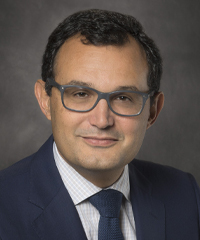Uncategorized
Myelodysplastic Syndrome & Acute Myeloid Leukemia
Insights on the Immunobiology of MDS and AML
Overview
Future paradigms for high-risk myelodysplastic syndrome (MDS) and acute myeloid leukemia (AML) might involve combinations of targeted therapies and immuno-oncology agents, in addition to more traditional therapies. Numerous immune-based therapies are in development, including novel checkpoint inhibitors against TIM-3 (eg, MBG453) and anti-CD47 antibodies (eg, magrolimab).
How might the biology of MDS and AML lend itself to treatment strategies that incorporate immuno-oncology agents?
David Sallman, MD
|
|
“Some of the newer nontraditional immune checkpoint inhibitors, such as those targeting CD47, have gained interest in AML and MDS research, especially in a particular subset of patients, which includes those with TP53 who typically have complex cytogenetics.”
The use of traditional checkpoints (eg, PD-1, PDL-1, or CTLA-4) as monotherapy for myeloid neoplasms has not been met with great success. However, there is great optimism for some of the newer immuno-oncology agents such as magrolimab and sabatolimab (MBG453), among others. Magrolimab is a monoclonal antibody against CD47, the dominant negative immune checkpoint of innate immunity via impairment of macrophage-mediated phagocytosis. Sabatolimab is a monoclonal antibody against TIM-3 representing a novel immune checkpoint on T cells. What we are seeing with these agents is an improved overall response rate and a deepening of the remissions. Translational work is still needed to better define minimal residual disease and its significance; however, we do know that a greater depth of remission improves long-term outcomes in the setting of transplantation. One question that frequently arises with TIM-3 and CD47 targeting is whether the increased activity is due to an immune augmentation or a potential direct impact on the leukemic stem cell. Further research is required to better understand the synergy and resistance mechanisms with these agents, including changes in the immune microenvironment and impact on leukemic stem cells.
Distinct from novel immuno-oncology agents, pevonedistat is a small-molecule inhibitor of NEDD8-activating enzyme that has also recently been shown to have synergistic response rates in combination with azacitidine in patients with higher-risk MDS and oligoblastic AML. How pevonedistat could potentially interact with novel immuno-oncology agents will need to be answered in future clinical trials.
Outcomes in patients with disease that is refractory to hypomethylating agents and hypomethylating agents in combination with venetoclax are quite dismal, so optimizing frontline therapy, particularly in older patients, will be critical to ensuring improved outcomes with these novel agents. However, some of the newer nontraditional immune checkpoint inhibitors, such as those targeting CD47, have gained interest in AML and MDS research, especially in a particular subset of patients, which includes those with TP53 who typically have complex cytogenetics. It is in this TP53-mutant group where there is the potential for actionable immune infiltration and disease with adverse features. Eprenetapopt, which may also enhance immune activation, is also promising in this context. Notably, investigation of novel triplets is likely to be a key task of future clinical trials, although we need to ensure the safety and tolerability of these combinations.
Guillermo Garcia-Manero, MD
|
|
“While we do not see the type of activity with immune checkpoint inhibitors that we see in many solid tumors, we are starting to observe important activity in patients with high-risk MDS and AML. The key will be identifying and selecting the appropriate group of patients who may benefit from this approach.”
I am familiar with the data from Borate et al on MBG453, and I think that MBG453 is an interesting molecule. These were early data with MBG453 combined with decitabine that appeared to show an increased response rate in high-risk MDS and AML. There are a number of other phase I/2 studies of interest, and there are also several exciting protocols that have been completed and some that are just starting, in both MDS and AML. The combinations of venetoclax and MBG453 are of great interest. One trial involves HDM201, which is an oral agent that inhibits degradation of TP53 by preventing HDM2 from binding to it. HDM201 in combination with MBG453 or venetoclax for AML or high-risk MDS is currently under investigation in Europe and the United States.
While we do not see the type of activity with immune checkpoint inhibitors that we see in many solid tumors, we are starting to observe important activity in patients with high-risk MDS and AML. The key will be identifying and selecting the appropriate group of patients who may benefit from this approach. For example, patients with secondary AML have more complex chromosomes and more frequent TP53 mutations. This is clinically significant because the TP53 gene renders the cells resistant to traditional chemotherapy, leading to poor patient prognosis. Novel therapies such as APR-246 or anti-CD47 antibody are starting to show clinical activity in this group of patients. Again, the selection of patients who could benefit from these treatment approaches will be critical.
Harry Paul Erba, MD, PhD
|
|
“If we want to be successful across the spectrum of the disease, it will require a deeper understanding of what is truly driving that leukemic stem cell. I envision that, at some point, we will be using a combination of targeted therapies and immunomodulation to treat patients.”
We are hopeful that targeting TIM-3 will achieve better results than what we have seen with the traditional checkpoints. Activating or reactivating antitumor immunity may be an effective treatment component, and I agree that we need a sophisticated analysis of that immune environment to better understand the patient population that would most likely benefit from these therapies.
An interesting related observation is from the clinical trial in MDS/AML evaluating flotetuzumab (a CD123 x CD3 bispecific dual antigen retargeting antibody) as salvage therapy: the patients who benefited the most were those who were most refractory to chemotherapy. Furthermore, there are data suggesting that chemotherapy refractoriness is associated with a particular immune signature. Therefore, identifying the immune phenotype of the microenvironment may help identify patients who could benefit from stimulating that T-cell infiltrate.
And, although we have had success recently with small molecules in AML, I think that it is helpful to take a step back to examine that success. For instance, in targeting FLT3 mutations, while we have seen a doubling of complete response and overall response rates with gilteritinib vs chemotherapy (10% vs 20% and 20% vs 40%, respectively), survival rates at 2 years were poor in both treatment groups. These data suggest that, while we seem to change the disease course to some degree, these agents are not disease modifying so as to put the disease into such a deep remission that we will not need other therapies. We have seen relatively high response rates in small cohorts of patients with MDS with IDH1 or IDH2 mutations who are given enasidenib or ivosidenib, respectively. However, if we want to be successful across the spectrum of the disease, it will require a deeper understanding of what is truly driving that leukemic stem cell. I envision that, at some point, we will be using a combination of targeted therapies and immunomodulation to treat patients.
References
Acharya N, Sabatos-Peyton C, Anderson AC. TIM-3 finds its place in the cancer immunotherapy landscape. J Immunother Cancer. 2020;8(1):e000911. doi:10.1136/jitc-2020-000911
Ando M, Ito M, Srirat T, Kondo T, Yoshimura A. Memory T cell, exhaustion, and tumor immunity. Immunol Med. 2020;43(1):1-9. doi:10.1080/25785826.2019.1698261
Best S, Lam V, Liu T, et al. Immunomodulatory effects of pevonedistat, a NEDD8-activating enzyme inhibitor, in chronic lymphocytic leukemia-derived T cells. Leukemia. 2020 Mar 16. doi:10.1038/s41375-020-0794-0
Boddu P, Kantarjian H, Garcia-Manero G, Allison J, Sharma P, Daver N. The emerging role of immune checkpoint based approaches in AML and MDS. Leuk Lymphoma. 2018;59(4):790-802. doi:10.1080/10428194.2017.1344905
Borate U, Esteve J, Porkka K, et al. Anti-TIM-3 antibody MBG453 in combination with hypomethylating agents (HMAS) in patients (PTS) with high-risk myelodysplastic syndrome (HR-MDS) and acute myeloid leukemia (AML): a phase 1 study. Accessed October 26, 2020. https://library.ehaweb.org/eha/2020/eha25th/295005/uma.borate.anti-tim-3.antibody.mbg453.in.combination.with.hypomethylating.html?f=listing%3D0%2Abrowseby%3D8%2Asortby%3D1%2Asearch%3Dmbg453
Borate U, Esteve J, Porkka K, et al. Phase Ib study of the anti-TIM-3 antibody MBG453 in combination with decitabine in patients with high-risk myelodysplastic syndrome (MDS) and acute myeloid leukemia (AML). Blood. 2019;134(suppl 1):570. doi:10.1182/blood-2019-128178
ClinicalTrials.gov. HDM201 in combination with MBG453 or venetoclax in patients with acute myeloid leukemia (AML) or high-risk myelodysplastic syndrome (MDS). Accessed October 26, 2020. https://clinicaltrials.gov/ct2/show/NCT03940352 term=MBG453&cond=MDS+or+AML&draw=2&rank=1
Dama P, Tang M, Fulton N, Kline J, Liu H. Gal9/Tim-3 expression level is higher in AML patients who fail chemotherapy. J Immunother Cancer. 2019;7(1):175. doi:10.1186/s40425-019-0611-3
Foran JM, DiNardo CD, Watts J, et al. Ivosidenib (AG-120) in patients with IDH1-mutant relapsed/refractory myelodysplastic syndrome: updated enrollment of a phase 1 dose escalation and expansion study. Poster presented at: 61st American Society of Hematology Annual Meeting; December 7-10, 2019; Orlando, FL.
Fu R, Li L, Hu J, et al. Elevated TIM3 expression of T helper cells affects immune system in patients with myelodysplastic syndrome [published correction appears in J Investig Med. 2020;68(4):e1]. J Investig Med. 2019;67(8):1125-1130. doi:10.1136/jim-2019-001059
Lamble AJ, Kosaka Y, Laderas T, et al. Reversible suppression of T cell function in the bone marrow microenvironment of acute myeloid leukemia. Proc Natl Acad Sci U S A. 2020;117(25):14331-14341. doi:10.1073/pnas.1916206117
Perl AE, Martinelli G, Cortes JE, et al. Gilteritinib or chemotherapy for relapsed or refractory FLT3-mutated AML. N Engl J Med. 2019;381(18):1728-1740. doi:10.1056/NEJMoa1902688
Sallman DA, McLemore AF, Aldrich AL, et al. TP53 mutations in myelodysplastic syndromes and secondary AML confer an immunosuppressive phenotype. Blood. 2020 Jul 30. doi:10.1182/blood.2020006158
Stein EM, Fathi AT, DiNardo CD, et al. Enasidenib in patients with mutant IDH2 myelodysplastic syndromes: a phase 1 subgroup analysis of the multicentre, AG221-C-001 trial. Lancet Haematol. 2020;7(4):e309-e319. doi:10.1016/S2352-3026(19)30284-4
Uy GL, Aldoss I, Foster MC, et al. Flotetuzumab, an investigational CD123 x CD3 bispecific Dart® protein, in salvage therapy for primary refractory and early relapsed acute myeloid leukemia (AML) patients. Blood. 2019;134(suppl 1):733. doi:10.1182/blood-2019-122073













